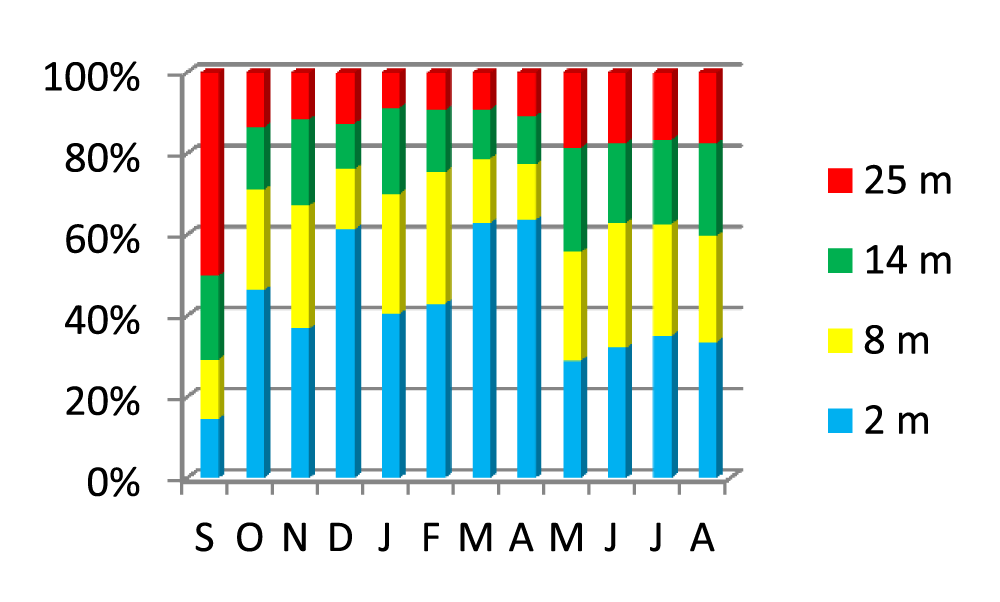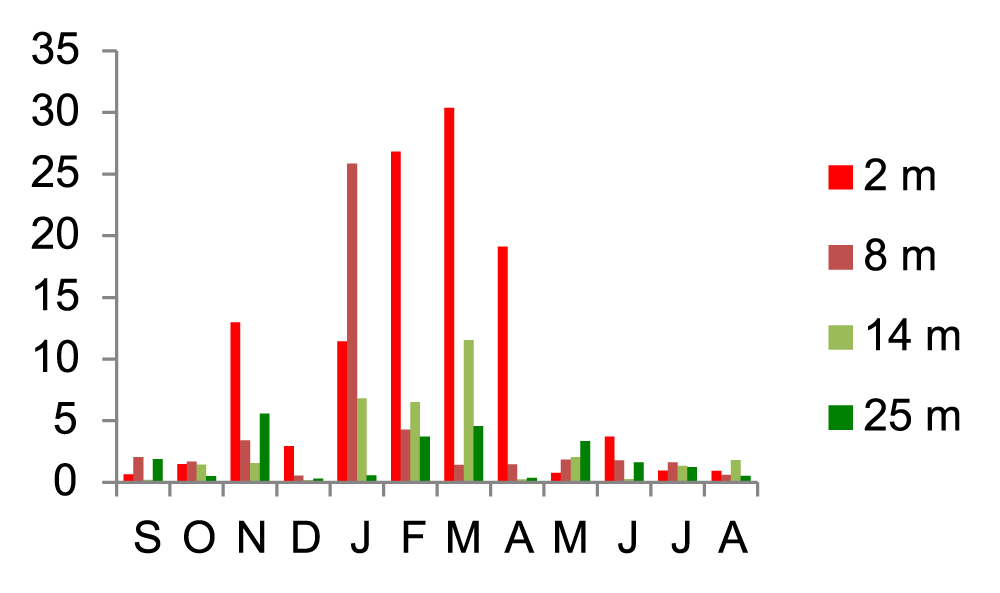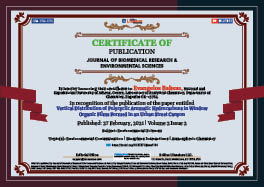> Environmental Sciences Group. 2021 Feb 27;2(2):091-094. doi: 10.37871/jbres1194.
Vertical Distribution of Polycyclic Aromatic Hydrocarbons in Window Organic Films Formed in an Urban Street Canyon
Ioannis Spiliopoulos and Evangelos Bakeas*
- Polycyclic aromatic hydrocarbons
- Window organic films
- Street canyons
- Vertical distribution
Abstract
Polycyclic Aromatic Hydrocarbon (PAHs) were determined in outdoor organic films formed on window glasses inside a street canyon at four different heights. The vertical distribution of PAHs in the organic film and the factors responsible for this have been studied. Significant changes of the concentration levels depending on the height and on the season were observed. The concentrations were elevated in the organic film at the street level and during the cold period. This work provides evidences that window organic film may pose an additional risk for human health in such locations through the accumulation of PAHs near the street level.
Introduction
Organic films onto impervious surfaces such as window glasses are derived through deposition of particles or the condensation of gas phase pollutants [1-3]. The concentration of semi-volatile organic compounds in organic films in urban areas has been found to be high. This is a result of the high organic content of organic films [2]. The deposition and wash-off are the two main processes which affect the air – organic film distribution of SVOCS making organic films to act as a sink and a source for these compounds. For this reason a variety of SVOCs have been determined in the surface films, such as Polycyclic Aromatic Hydrocarbons (PAHs), Polychlorinated Biphenyls (PCBs), Polybrominated Diphenyl Ethers (PBDEs), heavy metals and biogenic chemicals [2-6]. From this point of view, window organic film is a hazardous carrier of organic compounds which is closely related with atmospheric particles. This dynamic relationship, which is characterized from the resuspension into and redeposition from the atmosphere of the particles, makes clear that organic film should be considered as an air pollutant of concern for health impacts [7]. Until now, the health risk of organic film PAH exposure has not been studied in detail, especially in urban areas with high population or traffic load such as street canyons.
This work presents the first results for the vertical distribution of PAHs in the organic film developed on glass surfaces within a deep street canyon. The differences of PAHs’ concentration levels are studied in order to evaluate the accumulation of these compounds in different height above street level and the health risk related to this.
Experimental
Sampling and sample preparation
The street canyon (Patission Street) selected for this study is a typical example of the urban topography of Athens. It is located at the city center and is characterized by heavy traffic load mainly by light-duty gasoline vehicles. The buildings on both sides are nearly continuous with height up to 25 m. The street width is 20 m. Sampling was performed at four different sampling points, at 2, 8, 14 and 25 m above street level. Totally 48 samples were collected during one year. Details of the sampling method are presented in detail elsewhere [8]. Briefly organic film on windows was sampled by wiping. In all cases cleaned and dried kimwipes were firstly used followed by wetted kimwipes. Dichloromethane was used as solvent for the wet ones. Always, a 10-cm border was left around the outside of the window area. This was necessary for minimizing possible contamination from window sealant materials or paints. The organic film mass sampled from windows was determined gravimetrically. The procedure for PAHs extraction included a number of steps. Briefly, the samples were extracted with DCM (30 mL) in triplicate in an ultrasonic bath. The extracts were combined and concentrated. DCM was substituted with n-hexane, and then the sample was purified using silica – anhydrous sodium (1/1). PAHs were eluted with 10 mL of DCM and n-hexane solution (3:2, v/v)). Finally, the sample was reduced to 1 mL for gas chromatography/mass spectrometry (GC/MS) analysis. A GC/MS (6890N/5975B, Agilent Technologies, USA) was used. The injection was performed with a split/splitless injector. Pulsed splitless mode was used for the injection and the injector’s temperature was set at 280°C. The capillary column used was an HP-5ms [5%-(phenyl)-methylpolysiloxane] (Agilent J&W GC Columns, Agilent Technologies, USA). High purity helium was the carrier gas and the velocity was 1.5 mL min-1. The GC oven temperature program was: 55°C (hold for 1 min) to 320°C at 15°C min with final isothermal hold for 4 min. Inlet and MS source temperatures were 280°C and 230°C respectively. Selected Ion Monitoring (SIM) mode was used for the quantification of the analytes. The quality assurance included analysis of field and method blanks for checking any background contamination. Spiked blanks were used for the recovery experiments for the 16 PAHs and were ranged from 72 to 98%.
Statistical analysis
Statistical analysis was performed using SPSS software package (IBM SPSS statistics version 24). Mann Whitney test was employed to carry out if there was statistical significant difference. A value of p < 0.05 (95% confidence level) was considered to indicate a significant difference in the statistical analysis of the data. Spearman correlations used for the evaluation of possible associations among PAHs.
Results
The ΣPAHs concentrations levels were ranged from 15.2 to 540 ng m-2 for the different heights all over the year. The average value was found to be 108 ng m-2 and the geometric mean value to be 60.1 ng m-2. The highest contributors were Phe (33.3 ng m-2), Nap (11.3 ng m-2), Fluo (10.5 ng m-2) and Py (7.5 ng m-2). The percentage of high molecular weight PAHs (up to three rings, HMWPAHs) at street level was found to range from 32% (warm period) to 74% (cold period) of the ΣPAHs. This observed accumulation of HMWPAHs is due to the fact that are emitted mainly by the local traffic and are closely related to air particulate. Under cold conditions the particulates’ deposition on window surfaces is increased. This is also favored by their reduced photo-degradation by sunlight during the winter. Generally, it was observed that the height of 8 m above the street level was the “critical height” for HMWPAHs during the cold period due to the fact that their highest concentration percentage was found below this. The distribution pattern of ΣPAHs in different height inside the street canyon is shown in figure 1 and is quite similar to urban air particulate. As it is shown a clear seasonal variation of ΣPAHs levels in different heights was observed due to different deposition and adsorption rates. During the cold period the ratio of ΣPAHs2m/ ΣPAHs25m is increased comparing to that of the warm period having an average value of 4.7 instead of 1.8 for the warm period. Only in one case, during September, a reversed distribution of PAHs has been observed probably to their transportation from other areas. Such a large decrease in concentration with height has been found to be characteristic for pollutants, especially gaseous ones, emitted at street level and may indicate a similar distribution way for particle-bound PAHs in the organic film. For this reason the exponential expression (Εq. 1) for the vertical concentration profile C(z) of gaseous pollutants in the street canyons, proposed by several authors
(1)
where A, B, and q are regression coefficients depending on different parameters such as wind direction, atmospheric stability, and aerodynamic characteristics of the canyon has been fitted to the studied PAHs in the organic film. The results are given in table 1 and figure 2. According to the extracted r2 values it was obvious that during the cold period the vertical concentration profile C(z) of ΣPAHs is closely exponential instead of the warm period where such a relationship was not occurred. On the contrary, during the warm period the relationship tended to be linear. The vertical profile of course depends on the meteorology inside and above the street.
| Table 1: Fit results of Eq. 1 for the PAHs at different heights in the street canyon. | |||
| Month | B | q | r2 |
| S | 2.36 | -0.058 | 0.827 |
| O | 2.55 | -0.066 | 0.990 |
| N | 3.47 | -0.044 | 0.644 |
| D | 2,65 | -0.101 | 0.728 |
| J | 28.8 | -0.076 | 0.991 |
| F | 17.2 | -0.087 | 0.959 |
| M | 19.8 | -0.106 | 0.894 |
| A | 6.46 | -0.073 | 0.497 |
| M | 1.41 | -0.016 | 0.085 |
| J | 2.25 | -0.016 | 0.687 |
| J | 1.25 | -0.021 | 0.887 |
| A | 1.08 | -0.030 | 0.334 |
Canyon which favors the accumulation of the pollutants. Correlation of ΣPAHs with air temperature and relative humidity gave a significant correlation (r2 = 0.86) only with temperature.
In order to evaluate the impact of PAHs distribution in organic film inside the street canyon on the toxicity of the organic film, Toxic Equivalency Factors (TEFs) were employed. As it is known, the maximum TEF of 1 is assigned toBaP and other individual PAHs are relative to BaP as BaP-equivalents (BaPq) as given in Eq. (2):
(2)
where Ci is the individual PAH concentration and TEFi is the respective toxic equivalency factor.
Annually mean BaPq levels of PAHs was found to be 9.3 ± 10.8, 3.8 ± 6.9, 2.8 ± 3.6 and 2.0 ± 1.8 ng BaPq m-2 at the four different heights inside the street canyon (Figure 2). The maximum observed BaPq value was 30.4 ng m-2 at 2 m level. Greater rise in toxicity was observed during the cold period at 2 m about the street level. The same trend was also observed at 8 m and 14 m but to a lesser extent. Although the BaPq levels found in this work are lower than others reported for different sites [9] the windows organic film possesses high exposure risk to people being in the street canyon. For people permanently leaving in such locations this increased toxicity maybe an additional high risk factor due to the indoor/outdoor accumulation of organic film. For this reason organic film shall be considered as a source which significantly contributes to the human exposure affecting their health.
Conclusions
Sixteen PAHs in windows organic film developed in the vicinity of a street canyon, have been determined systematically. A strong vertical distribution of PAHs concentrations was identified. The vertical distribution was found to be exponential during the cold period, increasing the accumulation of PAHs at low heights near the street level. This affects the toxicity of window organic film which can be considered as a significant source of PAHs under specific conditions.
References
- Cetin B, Odabasi M. Polybrominated diphenyl ethers (PBDEs) in indoor and outdoor window organic films in Izmir, Turkey. J Hazard Mater. 2011 Jan 30;185(2-3):784-91. doi: 10.1016/j.jhazmat.2010.09.089. Epub 2010 Oct 20. PMID: 20961684.
- Pan SH, Li J, Lin T, Zhang G, Li XD, Yin H. Polycyclic aromatic hydrocarbons on indoor/outdoor glass window surfaces in Guangzhou and Hong Kong, south China. Environ Pollut. 2012 Oct;169:190-5. doi: 10.1016/j.envpol.2012.03.015. Epub 2012 Apr 11. PMID: 22497758.
- Gao W, Wu J, Wang Y, Jiang G. Distribution and congener profiles of short-chain chlorinated paraffins in indoor/outdoor glass window surface films and their film-air partitioning in Beijing, China. Chemosphere. 2016 Feb;144:1327-33. doi: 10.1016/j.chemosphere.2015.09.075. Epub 2015 Oct 23. PMID: 26479451.
- Li J, Lin T, Pan S-H, Xu Y, Liu X, Zhang G, Li X-D. Carbonaceous matter and PBDEs on indoor/outdoor glass window surfaces in Guangzhou and Hong Kong, south China. Atmos Environ. 2010;44:3254-3260. doi:10.1016/j.atmosenv. 2010. 05.057
- Liu QT, Chen R, McCarry BE, Diamond ML, Bahavar B. Characterization of polar organic compounds in the organic film on indoor and outdoor glass windows. Environ Sci Technol. 2003 Jun 1;37(11):2340-9. doi: 10.1021/es020848i. PMID: 12831015.
- Liu QT, Diamond ML, Gingrich SE, Ondov JM, Maciejczyk P, Stern GA. Accumulation of metals, trace elements and semi-volatile organic compounds on exterior window surfaces in Baltimore. Environ Pollut. 2003;122(1):51-61. doi: 10.1016/s0269-7491(02)00286-5. PMID: 12535595.
- Wang W, Huang MJ, Kang Y, Wang HS, Leung AO, Cheung KC, Wong MH. Polycyclic aromatic hydrocarbons (PAHs) in urban surface dust of Guangzhou, China: Status, sources and human health risk assessment. Sci Total Environ. 2011 Oct 1;409(21):4519-27. doi: 10.1016/j.scitotenv.2011.07.030. PMID: 21855957.
- Yu Y, Yang Y, Liu M, Zheng X, Liu Y, Wang Q, Liu W. PAHs in organic film on glass window surfaces from central Shanghai, China: distribution, sources and risk assessment. Environ Geochem Health. 2014 Aug;36(4):665-75. doi: 10.1007/s10653-013-9588-x. Epub 2013 Dec 12. PMID: 24337860.
- Hussaina K, Rahmanb M, Prakasha A, Hoquea R-R. Street dust bound PAHs, carbon and heavy metals in Guwahati city – Seasonality, toxicity and sources. Sustainable Cities and Society. 2015;19:17-25. doi: 10.1016/j.scs.2015.07.010
Content Alerts
SignUp to our
Content alerts.
 This work is licensed under a Creative Commons Attribution 4.0 International License.
This work is licensed under a Creative Commons Attribution 4.0 International License.










